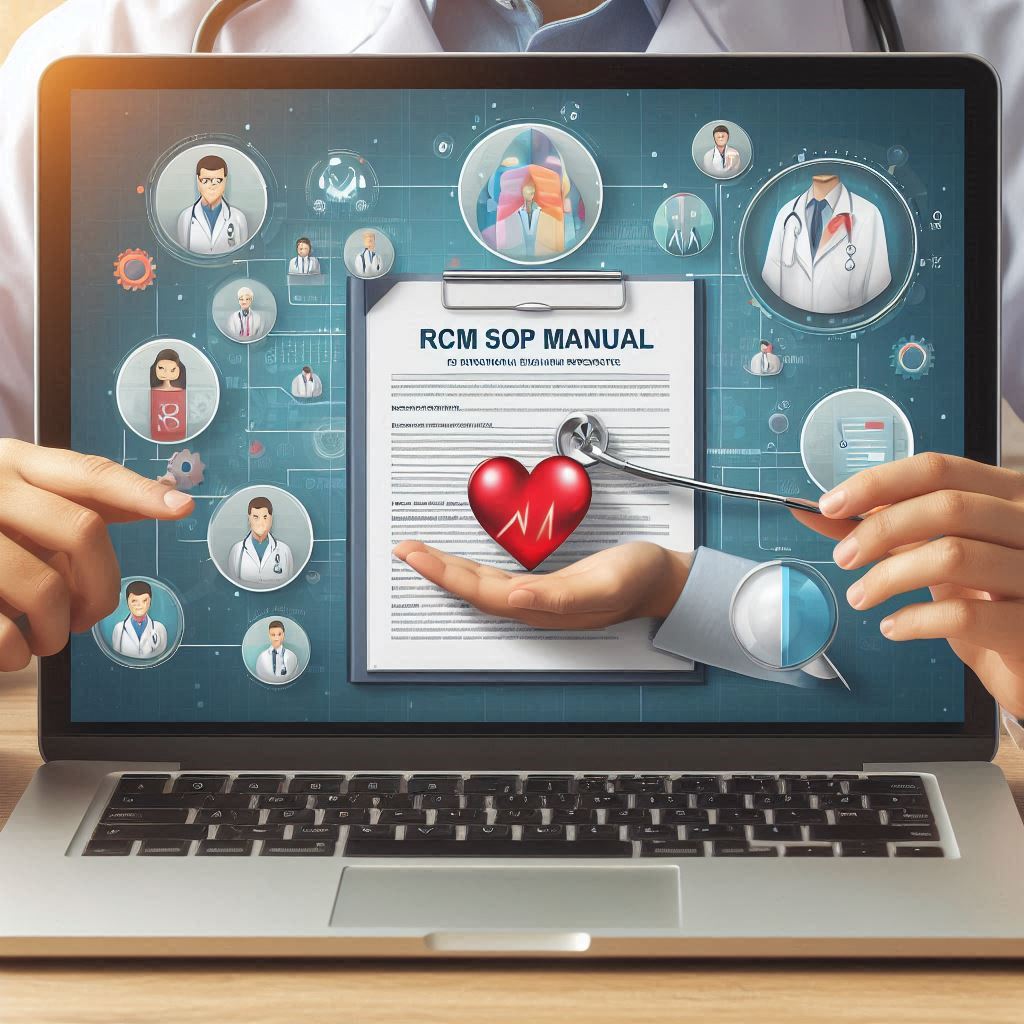In the ever-evolving world of behavioral health, efficiency, compliance, and financial sustainability are more than just buzzwords—they are pillars that support successful clinical outcomes and thriving practices. A well-crafted Revenue Cycle Management (RCM) Standard Operating Procedure (SOP) manual is one of the most crucial documents a behavioral health organization can possess. It serves as the backbone of administrative operations, helping clinical and non-clinical staff understand, execute, and optimize every step of the revenue cycle. This guide provides an in-depth, step-by-step roadmap to creating a robust RCM SOP manual tailored for behavioral health practices.
Understanding the Role of an RCM SOP Manual
What Is an SOP Manual in RCM?
An RCM SOP Manual is a comprehensive, structured document that defines and standardizes all processes related to the financial lifecycle of a patient—from intake and insurance verification to claim submission, reimbursement, and patient collections.
In behavioral health, where regulations are complex and claims are often rejected due to documentation issues or coding errors, a clear SOP helps mitigate risks and ensures consistency across staff.
Why Behavioral Health Is Different
Behavioral health providers deal with:
- Multiple payer rules (Medicaid, Medicare, commercial plans, EAPs)
- Frequent claim rejections due to time-based CPT coding and documentation requirements
- Confidentiality mandates like 42 CFR Part 2
- Out-of-network billing, single case agreements, and telehealth-specific modifiers
These nuances necessitate a behavioral health–specific SOP rather than a generic healthcare manual.
Understanding the Behavioral Health RCM Landscape
Unique Challenges in Behavioral Health Revenue Cycle
Behavioral health revenue cycles are shaped by unique variables:
- High denial rates due to documentation variances.
- Prior authorization requirements for therapy and psychiatric sessions.
- Complicated coding (e.g., CPT 90837 vs. 90834).
- Coordination of care across multiple disciplines (psychiatrists, therapists, social workers).
- Sliding fee scales and grant funding in community health settings.
- Confidentiality regulations under 42 CFR Part 2 that limit data sharing.
An effective SOP must address these particularities head-on.
The RCM Continuum in Behavioral Health
A behavioral health RCM manual must be structured around the full revenue cycle:
- Front-end: Scheduling, eligibility, authorizations, intake.
- Mid-cycle: Documentation, coding, charge entry.
- Back-end: Billing, payment posting, denial management, and collections.
Key Components of a Behavioral Health RCM SOP Manual
Front-End RCM Operations
These are the first touchpoints with patients and include:
Patient Scheduling
- Define how appointments are scheduled (phone, online portal, walk-in)
- Include appointment types: intake, therapy, group, med management
- Specify time allotments for each type
Insurance Verification
- Step-by-step script and checklist for insurance verification
- Portals used for eligibility (Availity, payer portals, CAQH)
- Verification of behavioral health benefits: copay, deductible, sessions allowed
Prior Authorization
- List of services requiring pre-auth (e.g., intensive outpatient programs)
- Templates for submitting documentation
- Escalation procedures for denials
Patient Intake
- Required forms (HIPAA, Consent to Treat, Release of Information)
- Patient demographics and insurance data entry SOP
- EHR documentation standards
Mid-Cycle RCM Operations
Mid-cycle activities focus on clinical documentation and coding.
Clinical Documentation
- SOAP or DAP note templates
- Session length requirements
- Medical necessity documentation guide
Coding Guidelines
- Time-based CPT codes (e.g., 90834, 90837)
- Add-on codes (e.g., +90785 for interactive complexity)
- Group therapy, family therapy, telehealth-specific codes
- ICD-10-CM diagnostic coding SOPs
- Documentation-to-code matching checklist
Charge Entry
- Timeline: within 24–48 hours of service
- Role responsibilities (e.g., clinician vs. billing team)
- Data entry SOP: matching CPT, modifiers, place of service
Back-End RCM Operations
Back-end processes focus on billing, claims, and collections.
Claims Submission
- Daily batch claim submission via clearinghouses
- Scrubbing tools and error resolution procedures
- Claim file formats (ANSI 837, HCFA 1500)
Payment Posting
- Manual vs. auto-posting protocols
- ERA/EOB reconciliation processes
- Handling adjustments, denials, and take-backs
Denial Management
- Denial log templates
- Appeal letter templates and turnaround expectations
- Tracking overturned denials vs. write-offs
Patient Statements and Collections
- Monthly statement cycle dates
- Collection policy (grace period, payment plans)
- Soft collections vs. agency involvement
- Documentation of hardship waivers and payment agreements
SOP Manual Structure and Formatting
SOP Template Framework
Each section of your SOP should include the following:
| Section | Content |
|---|---|
| Title | Clearly define the task (e.g., “Insurance Verification Procedure”) |
| Objective | Purpose of the SOP |
| Scope | Who the SOP applies to |
| Responsibility | Role(s) responsible |
| Procedure | Step-by-step, numbered instructions |
| Tools Used | Software, portals, or forms |
| References | Policies, payer guidelines |
| Revision Date | Last update timestamp |
Visual Aids and Flowcharts
Use:
- Swimlane diagrams for multi-department processes
- Checklists for intake and billing audits
- Screenshots for EHR instructions or clearinghouse steps
Version Control and Updates
- Maintain a revision log
- Appoint an RCM compliance officer or manager to review SOPs quarterly
- Ensure staff acknowledgment with signature log after each update
Building the SOP Team and Assigning Roles
Creating an RCM SOP is not a one-person job. It requires input from:
Billing Staff
They clarify current workflows, payer nuances, and pain points.
Clinical Providers
Help align documentation practices with coding and compliance needs.
Front Desk Staff
Offer insight into patient scheduling, intake, and insurance collection bottlenecks.
Compliance Officer
Ensures policies follow HIPAA, 42 CFR Part 2, and payer rules.
E. IT & EHR Admin
Support integration of SOPs into digital workflows.
Common SOP Modules in Detail
Eligibility & Benefits Check
Objective: Ensure all behavioral health benefits are verified prior to treatment.
Steps:
- Access payer portal or call insurer.
- Verify:
- Behavioral health coverage
- Authorization needs
- Limits (annual sessions)
- Copay/coinsurance
- Record in EHR under “Insurance Notes”
- Alert clinician and billing if pre-auth is required
Tools: Availity, PracticeSuite, Kareo, EHR systems
Coding for Therapy Sessions
Objective: Accurately code all behavioral health sessions.
Steps:
- Review session duration.
- Select CPT based on time (e.g., 90837 for 60 mins).
- Include modifier (e.g., 95 for telehealth).
- Match with diagnosis (ICD-10).
- Ensure clinician signs documentation.
Common Mistakes to Avoid:
- Using 90834 (45 min) for 60-minute sessions
- Billing without signed notes
Claims Scrubbing and Submission
Objective: Submit clean claims to payers promptly.
Steps:
- Export batch from EHR
- Run through scrubbing tool
- Fix any flagged errors
- Submit via clearinghouse
- Monitor claim status dashboard
Turnaround Time: 1–2 business days
Red Flags:
- Missing taxonomy
- Invalid NPI or rendering provider mismatch
Denials and Appeals
Objective: Minimize lost revenue due to denied claims.
Steps:
- Review EOB or denial code
- Log denial reason
- Retrieve session note, pre-auth, and claims file
- Draft appeal using payer format
- Submit within 30 days
Tracking:
- Use Excel or denial management software (e.g., Waystar)
- Track appeal success rate monthly
Payment Plans and Collections
Objective: Maintain patient trust while recovering revenue.
Steps:
- Offer payment plan if balance > $100
- Document agreement in patient portal
- Send soft reminders via SMS or email
- Escalate to collections after 90 days
Best Practices:
- Offer online payment options
- Avoid sending balances to collections without multiple contacts
SOP Compliance, Auditing, and Staff Training
Internal Audits
- Perform monthly chart audits for documentation-to-code accuracy
- Randomly audit 10% of denied claims
Staff Training
- Quarterly RCM refreshers
- Annual HIPAA & 42 CFR training
- Use quizzes and case studies
Compliance Monitoring
- Appoint RCM compliance lead
- Log incidents and corrective actions
SOP Accessibility
- Store digitally (SharePoint, GDrive)
- Ensure read-only access
- Track acknowledgments via e-signature
Integrating SOPs with Technology
EHR Integration
- Use task automation (e.g., alerts for unsigned notes)
- Embed SOP checklists within the clinical workflow
Clearinghouse Integration
- Set up auto-scrub rules and reject alerts
- Use dashboards to track clean claim rate
RCM Analytics
- SOP should define key performance indicators:
- First pass resolution rate (FPRR)
- Denial rate
- Days in A/R
- Patient collection ratio
AI & Automation Tools
- Predictive denial analysis
- AI-assisted coding validation
- Chatbots for patient balance inquiries
Sample SOP Snippet – Insurance Verification
Title: Insurance Verification for Behavioral Health Services
Objective: Ensure accurate and timely verification of patient insurance to prevent claim denials
Scope: Front desk, intake specialists
Responsibility: Front desk and insurance verification coordinator
Procedure:
- Upon scheduling, ask for insurance card (front/back)
- Log into Availity or payer portal
- Search by NPI and patient DOB
- Confirm:
- Active behavioral health coverage
- Copay/Coinsurance
- Session limits
- Telehealth coverage
- Enter verified details into EHR “Insurance Notes”
- Flag patient account if prior authorization required
Tools: Availity, Kareo EHR, PracticeSuite
Revision Date: June 1, 2025
Challenges in SOP Implementation and How to Overcome Them
Challenge 1: Staff Resistance to Change
Solution: Involve team in SOP creation. Offer hands-on training.
Challenge 2: SOPs Becoming Outdated
Solution: Set quarterly review cycles with assigned owners.
Challenge 3: Inconsistent Execution
Solution: Use audits and KPIs to monitor SOP adherence.
Challenge 4: Software Misalignment
Solution: Customize EHR workflows to reflect SOP logic.
Conclusion
Creating a Revenue Cycle Management SOP manual for a behavioral health practice isn’t merely a bureaucratic exercise—it is a strategic investment in operational efficiency, compliance, and long-term financial viability. By codifying workflows, clarifying responsibilities, and embedding accountability into daily routines, practices can transition from reactive problem-solving to proactive performance management. The complexities of behavioral health billing—from 42 CFR Part 2 compliance to nuanced coding—demand more than general medical SOPs. A tailored manual ensures that staff at every level, from front desk to back-end billing, follow a synchronized playbook.
However, a manual is only as effective as its execution. Leadership must commit to consistent training, regular updates, and a culture of transparency and communication. Involving staff in SOP refinement not only increases buy-in but also ensures real-world practicality. With this comprehensive RCM SOP manual in place, behavioral health practices can minimize denials, shorten revenue cycles, meet compliance requirements, and—most importantly—redirect their focus toward what matters most: improving lives through quality mental health care.
SOURCES
Centers for Medicare & Medicaid Services. (2023). Medicare Program Integrity Manual.
Green, J. (2022). Behavioral Health Billing Essentials. Health Admin Press.
Kaufman, N. (2021). SOP Implementation Strategies in Behavioral Health Practices. Journal of Behavioral Healthcare Administration, 18(2), 100–115.
Smith, R. (2023). Creating SOPs for Mental Health Clinics. Healthcare Financial Management Journal, 77(5), 43–55.
Taylor, M. (2024). Revenue Cycle Management for Behavioral Health. McGraw-Hill Professional.
U.S. Department of Health and Human Services. (2024). HIPAA Compliance Guide.
Zane, H. (2022). Common Billing Errors in Psychiatry and How to Prevent Them. Medical Billing Today, 29(3), 22–28.
HISTORY
Current Version
June 30, 2025
Written By:
SUMMIYAH MAHMOOD








Leave a Reply